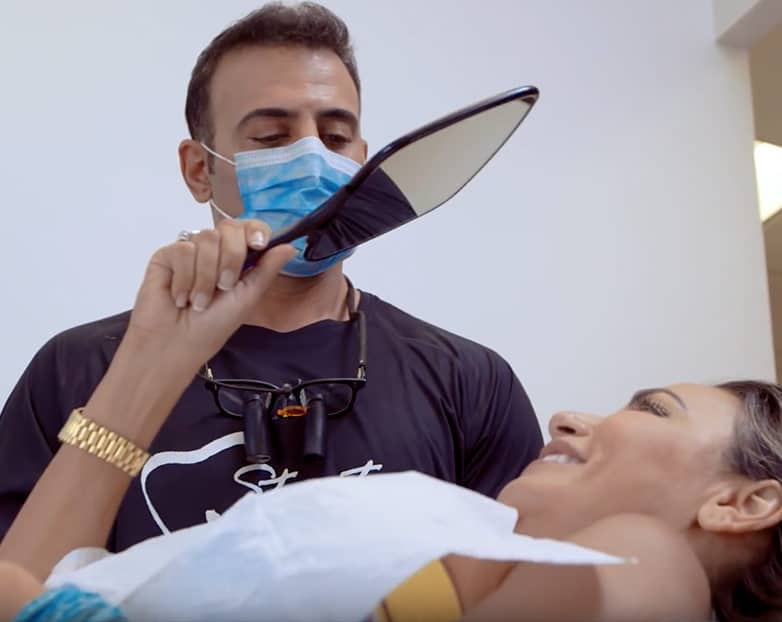Veneers are a VERY special subject for us. If ever the phrase "Not all ______ are created equal" were applicable, it would be in reference to veneers. First, let's talk about what a veneer is and then it will become more clear why there is such a wide diverse range of options and choices.
A veneer is a thin laminate of porcelain that is bonded to the front of a tooth to completely change the aesthetic appearance of the tooth. Many patients think that veneers and crowns are interchangeable but they are very different restorations and are done for different reasons.
With custom dental veneers in Fort Lauderdale made by Dr. Stanton, you can have a smile that lets you feel your most confident, attractive and self-assured. A veneer should be very conservative requiring only a very small amount of tooth preparation (drilling) on the front and sometimes the sides of the tooth only. A crown requires all five surfaces of the tooth to be prepped and to a greater extent. It's never really a choice whether to have a veneer or a crown -- the condition of the tooth and the desired result will determine which restoration is best suited.
UNDERSTANDING DENTAL VENEERS FORT LAUDERDALE
One of the most common things we hear when discussing veneers is "Oh I've seen veneers before. They look so fake. They're too thick, white and unnatural." Unfortunately, there are veneers done every day by dentists that do not fully understand all the necessary principles of veneer preparation and esthetics, and thus get results with veneers that look unnatural. These unesthetic are the cases that stand out and get noticed. If dental veneers in Broward County are done properly, you will not notice them, and you will simply think you are talking to someone who has really nice teeth!
It's the same with any man-made result that tries to mimic nature whether it be rhinoplasty, breast augmentation, hair grafting, etc. If the doctor correctly mimics the ideal natural result, then the patient looks naturally ideal and not unnaturally enhanced, and those around the patient do not notice or remark that something stands out because it doesn't stand out. It blends in naturally the way it should.

So why do so many people get unnatural veneers?
The reason is simple. The way most doctors do their crowns is standard in the sense that they prep or modify the tooth to standard guidelines, take an impression, send it to the lab with a prescription on which they usually just write the desired shade they want rather than a detailed request of shape size texture and properties of color and then the lab sends back a crown that fits the space and is that generic shade. For a simple crown in the back of the mouth, that process may work because back teeth require less design and aren’t often visible. Think about their perimeters. There is a tooth directly in front, another directly behind and another directly opposite that it bites into so those three teeth set the perimeter of the crown. The other two surfaces are lined up with the neighboring teeth and you end up with a crown that fits. Obviously, you would like all crowns to be esthetically ideal and match perfectly, but again, if a crown in the back of the mouth isn't a perfect match, most patients will be ok with this outcome because it’s extremely difficult for other people to see the crown.
VENEERS ARE NOT "MINI-CROWNS"
Veneers are a completely different story. When you provide a patient with veneers, you are designing the entire smile from scratch. And in order to properly design a patient's smile, you must understand the principles of proportion, symmetry, lip and muscle activity and facial characteristics, and how ALL those factors harmonize into a smile that looks natural AND functions properly. You cannot just simply prepare teeth, take an impression and send it to the lab with a generic shade request and hope for quality results. Unfortunately, this is exactly how most veneers today are made, so it is no surprise that the results look unnatural because so many of the contributing principles are ignored. How is a lab technician sitting in a dental lab miles away with stone models supposed to know exactly where to put every little contour and edge of every surface of every veneer? How is that lab tech supposed to know not just the shade, but the brightness of the shade? What about the level of saturation of the shade? What about the surface characterization and texture of the ceramic itself? There are so many factors the go into a veneer that harmonizes with everything, which is why when people want veneers done properly, they visit Dr. Stanton.
So far we have focused on the dentist’s challenges in designing veneers properly. What about the actual material used? Patients think that all veneers are made of porcelain, which they are, but most people don’t know that not all Ft. Lauderdale porcelain veneers are created equal. Porcelains can be hand be hand-mixed, pressed or milled from blocks. Pressed porcelains and milled porcelains have similar strength but milled porcelain has the added benefit of being fabricated in a consistent industrial setting, so the material is uniform. Milled porcelains also have the same refractory index as natural enamel and wear resistance of natural enamel (see below). Thus, after decades of use, teeth opposing milled restorations show no excessive wear (which is our aim).
The refractory index refers to the way that light behaves when it enters the material. The reason why some veneers and crowns look fake even though they are the same color is due to the refractory index. Enamel has a diamond-like quality that caused light to dance around and bounce around to the viewer while layered porcelain does not. This will obviously create a difference to the viewer. Wear resistance is the quality of hardness, not strength, but the amount of wearing down the porcelain causes to the opposing teeth it interacts with. Some porcelain veneers in Fort Lauderdale have wear resistance so high that after several years of use, the opposing natural teeth display excessive enamel loss and damage.
A CUSTOMIZED APPROACH SETS DR. STANTON APART
We have reviewed the importance of proper and adequate smile design training and knowledge of materials in fabricating veneers, and we now move on to the Stanton Method. This is the last and perhaps most important factor in the fabrication of natural, beautiful and durable veneers.
Many people expect that veneers are simply cemented to the teeth they are designed for. In actuality, however, Fort Lauderdale veneers are bonded to the teeth with resin. Proper resin bonding requires a very technique sensitive process that has multiple steps which must be performed exactly as prescribed or the final bond strength will be compromised.
One important factor in securing a high bond strength is the health of the prepared tooth and the hydration of the tooth's collagen. The collagen is healthiest the moment the tooth is prepped, and begins to dry out from that point on. So do you think it is most hydrated a few hours after is it is prepped - or after a few weeks? Of course, there is a huge difference between a few hours and a few weeks which is why the staple of the Stanton Method of dental veneers before and after is bonding the ceramic to the tooth within hours of the tooth being prepped.


You may be wondering if it takes a laboratory several weeks to fabricate porcelain veneers Fort Lauderdale, how can we do it in a few hours? The answer is technology and experience. Our CADCAM systems allow us the opportunity to fabricate our own ceramic porcelain restorations in minutes and our mastery of these systems after doing thousands of these restorations over the past ten years is what allows us to get predictable consistent results in one appointment. Our patients experience something that very few patients in the world get to experience. They receive ideally designed restorations that fit all esthetic principles of symmetry and proportion made out the strongest and prettiest materials available that perform the most like natural teeth in the mouth and are bonded to the teeth with the highest possible strength such that they never fall out on their own. That is the Stanton Method of doing dental veneers in Broward County and that is why all veneers are not created equal. See examples of Dr. Stanton’s patients with their new veneers in our veneer gallery.
